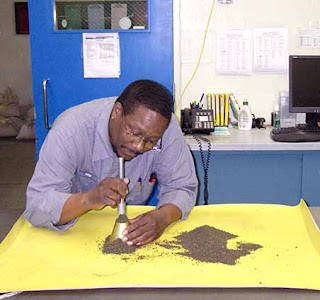What do RAP and HIP have in common? Not what you’re thinking
Posted by Unknown on Wednesday, August 17, 2011
State Materials Lab uses science to make transportation sustainable, affordable
by guest blogger Noel Brady
Reduce, reuse, recycle. We’ve all heard it before; some of us hear it in our sleep. But what does it mean to us?
 |
| Hot In Place (HIP) Paver |
Take the asphalt you drive on every day, for instance. We’ve been recycling and reusing asphalt pavement for nearly 35 years. Today, the agency is a leader in an industry that now recycles nearly 100 percent of asphalt pavement nationwide.
We maintain more than 20,500 lane miles on state highways and other roadways, almost enough to wrap a road around the globe. About 63 percent of those lane miles are topped with recycled asphalt pavement (RAP), which gets reused again and again.
The Materials Lab takes a basic dollars-and-common-sense approach to their work. Simply put, they use chemistry and physics to get bigger bangs for dwindling bucks. In today’s climate – both economic and atmospheric – sustainability is just as important to our budget’s bottom line as it is to the environment. Innovations being refined and enhanced in the lab aim to trim the price of pavement by making it stronger and last longer.
 |
| Tony Briscoe testing pavement materials |
Other DOTs design and build asphalt pavement to last 20 years; then they replace it completely. We do it differently. Take I-90, for instance; that pavement is 43 years old, 3 4 inches thicker than the 20-year stuff and still going strong with resurfacing every 10-15 years.
The lab is exploring new ways to cut cost and greenhouse gas emissions with new methods like hot-in-place (HIP), which recycles and reuses old asphalt without ever leaving the work zone.
 |
| Alan Bacon testing pavement materials |
In recent years, the lab has changed paving as we know it in Washington by refining a method for mixing asphalt 50 degrees cooler than the standard 300 degrees before spreading it in on the road. Less heat means less fuel and less greenhouse gas spewed into our air. Today, the so-called warm-mix method of asphalt paving uses 20 percent less energy. When combined with RAP it cuts greenhouse gas emissions by 15-20 percent – about 3 million tons of carbon dioxide per year not fouling our air.
Regardless of how you define sustainability, the lab uses science and technology to help us spend tax dollars more wisely and make highways, bridges and tunnels stronger, safer, longer lasting and gentler on the places we call home. It’s one of many ways we’re making transportation better.
This entry was posted on Wednesday, August 17, 2011 at 10:58 AM. You can follow any responses to this entry through the RSS 2.0. You can leave a response.
- No comments yet.






